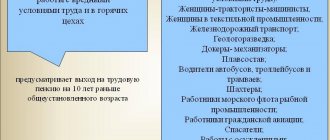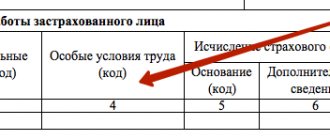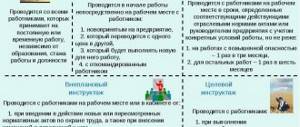20.08.2019
1
64
4 min.
Analysis of the determining factors of work allows us to assign special guarantees and compensation. Article 147 of the Labor Code of the Russian Federation regulates payment for work related to the performance of duties in harmful or especially dangerous situations. To receive an increase in monthly remuneration, a number of points must be observed (important for both the employee and the enterprise). Otherwise, the charges will be considered illegal or fraudulent.
Payment procedure
Article 147 of the Labor Code of the Russian Federation determines the minimum interest rate and the procedure for remuneration for the category of workers whose professional activities are associated with non-standard conditions. Types of compensation for employees employed in such production:
- financial compensation - an increase of 4% of the tariff rate (the enterprise has the right to assign more, the article establishes only a minimum limit, for harmful conditions it reaches 12%, for especially dangerous conditions - 24%);
- provision of additional vacation days (minimum number - 7 days);
- reduction of work time per week - up to 36 hours instead of the standard 40;
- early retirement, calculation of the corresponding monetary remuneration.
First of all, it is necessary to determine the class and subcategory in accordance with Art. 14 of the Labor Code of the Russian Federation. Professions of levels 3 and 4 are subject to additional financial incentives without fail. Action steps:
- setting the required amount of compensation (industry agreements and the opinion of trade unions are taken into account);
- entering data (amount of payment, accrual procedure, categories of employees according to the staffing table) into the local internal regulations of the enterprise;
- signing an additional agreement to the employment contract;
- direct provision of compensation accruals.
Additional payment can be made through a collective agreement with employees of the organization or by issuing separate acts. After conducting an examination for hazardous working conditions that comply with the Labor Code, an order is issued, which includes:
- results of the commission's research;
- employee positions.
Attention! An order can be issued for a specific employee or for several at the same time (for example, for a department, team, structural unit). If the conditions for the bonus are fixed in the collective agreement, accruals are made automatically by the accounting department.
Commentary on Article 147 of the Labor Code of the Russian Federation
For workers engaged in work with harmful and (or) dangerous working conditions, wages are set at an increased rate compared to tariff rates, salaries (official salaries) established for various types of work with normal working conditions.
At the same time, the amount of remuneration for this category of workers cannot be lower than the amount established by labor legislation and other regulatory legal acts containing labor law norms. Thus, Part 2 of the commented article establishes the minimum amount of increase in wages for workers engaged in work with harmful and (or) dangerous working conditions, which is 4 percent of the tariff rate (salary) established for various types of work with normal working conditions.
It should be noted that the classification of working conditions in workplaces as harmful or dangerous working conditions for the purposes provided for by labor legislation, from January 1, 2014, is carried out on the basis of the results of a special assessment of working conditions in accordance with the requirements of Federal Law of December 28, 2013 N 426 -FZ.
As noted by the Ministry of Labor of Russia, Federal Law No. 421-FZ of December 28, 2013 “On Amendments to Certain Legislative Acts of the Russian Federation in Connection with the Adoption of the Federal Law “On Special Assessment of Working Conditions,” which came into force on January 1, 2014, The Labor Code of the Russian Federation has been amended to establish a differentiated approach to determining the type and volume of guarantees and compensation provided to employees engaged in work with harmful or dangerous working conditions (Articles 92, 117, 147 of the Labor Code of the Russian Federation). At the same time, the transitional provisions of Art. 15 of the Federal Law of December 28, 2013 N 421-FZ provides that when implementing compensation measures aimed at mitigating the negative impact on their health of harmful and (or) dangerous working conditions, hazardous factors of the production environment and the labor process (reduced working hours, annual additional paid leave or monetary compensation for them, as well as increased wages), the procedure and conditions for the implementation of such measures cannot be worsened, and the amounts reduced in comparison with the procedure, conditions and the amount of compensation measures actually implemented in relation to these employees as of the day the said Federal Law entered into force, provided that the appropriate working conditions in the workplace, which served as the basis for the appointment of the implemented compensation measures, are maintained. Thus, by the time Federal Law No. 421-FZ of December 28, 2013 came into force, the types and achieved amounts of guarantees (compensations) provided to employees in whose workplaces, based on the results of workplace certification carried out before December 31, 2013, harmful working conditions were established (dangerous) working conditions must be maintained until working conditions at these workplaces are improved, confirmed by the results of a special assessment of working conditions.
________________ Official website of the Russian Ministry of Labor. Model questions and answers (explanation of the Russian Ministry of Labor on the most frequently encountered questions about the special assessment of working conditions). https://www.rosmintrud.ru/docs/mintrud/salary/20.
To establish the appropriate amount of compensation, the employer can use the List of industries, workshops, professions and positions with hazardous working conditions, work in which gives the right to additional leave and a shortened working day, approved by Resolution of the State Committee for Labor of the USSR, the Presidium of the All-Union Central Council of Trade Unions dated October 25, 1974 N 298/P -22, Instructions on the procedure for applying the List of industries, workshops, professions and positions with hazardous working conditions, work in which gives the right to additional leave and a reduced working day, approved by Resolution of the State Committee for Labor of the USSR, the Presidium of the All-Union Central Council of Trade Unions dated November 21, 1975 N 273/P- 20, as well as the Standard Regulations on the assessment of working conditions in workplaces and the procedure for applying sectoral lists of work for which additional payments to workers for working conditions can be established, approved by Resolution of the State Committee for Labor of the USSR, the Presidium of the All-Union Central Council of Trade Unions dated October 3, 1986 N 387/22-78, and other current regulatory legal acts establishing the appropriate amounts of compensation, to the extent that does not contradict the Labor Code of the Russian Federation (see. decision of the Supreme Court of the Russian Federation of January 14, 2013 N AKPI12-1570 “On the refusal to satisfy the application for recognition as partially invalid paragraph 1 of the resolution of the State Committee for Labor of the USSR, the Presidium of the All-Union Central Council of Trade Unions of October 25, 1974 N 298 / P-22, paragraphs 1 and 4 of the Instructions on the procedure application of the List of industries, workshops, professions and positions with hazardous working conditions, work in which gives the right to additional leave and a shortened working day, approved by Resolution of the USSR State Labor Committee, the Presidium of the All-Union Central Council of Trade Unions dated November 21, 1975 N 273/P-20").
The specific amounts of wage increases are established by the employer, taking into account the opinion of the representative body of employees in the manner established by Art. 372 of the Labor Code of the Russian Federation for the adoption of LNA, or a collective agreement, an employment contract.
At the same time, in accordance with Article 219 of the Labor Code of the Russian Federation, if safe working conditions are provided at workplaces, confirmed by the results of certification of workplaces for working conditions, compensation for workers is not established.
Another comment to Art. 147 Labor Code of the Russian Federation
1. The commented article is special in relation to Art. 146 of the Labor Code and provides for increased pay due to special working conditions.
2. In contrast to the previously existing procedure, enshrined in the previous edition of Part 2 of Art. 147 of the Labor Code, which provided that the minimum amount of increase in wages for employees engaged in work with special working conditions, and the conditions for this increase should be established in the manner determined by the Government of the Russian Federation, taking into account the opinion of the Russian Tripartite Commission for the Regulation of Social and Labor Relations, now the minimum amount of increase set by the legislator at a rate of at least 4%.
3. The specific form of increase, as well as its size, are established by the employer, taking into account the opinion of the representative body of employees or by a collective agreement.
As indicated in the information letter of the Ministry of Labor and Social Protection of the Russian Federation dated February 13, 2013, taking into account the decision of the Supreme Court of the Russian Federation dated January 14, 2013 N AKPI12-1570, to establish the appropriate amount of compensation, the employer can use the List of industries, workshops, professions and positions with harmful working conditions, work in which gives the right to additional leave and a reduced working day, approved. Resolution of the State Committee of the Council of Ministers of the USSR on labor and wages, the Presidium of the All-Union Central Council of Trade Unions dated October 25, 1974 N 298/P-22, Instructions on the procedure for applying the List of industries, workshops, professions and positions with hazardous working conditions, work in which gives the right for additional leave and shortened working hours, approved. Resolution of the State Committee of the Council of Ministers of the USSR on labor and wages, the Presidium of the All-Union Central Council of Trade Unions dated November 21, 1975 N 273/P-20, as well as the Standard Regulations on the assessment of working conditions in the workplace and the procedure for applying sectoral lists of work for which labor standards may be established additional payments to workers for working conditions, approved. Resolution of the State Committee of the Council of Ministers of the USSR on labor and wages, the Presidium of the All-Union Central Council of Trade Unions dated October 3, 1986 N 387/22-78, and other current regulatory legal acts establishing the appropriate amounts of compensation, to the extent that does not contradict the Labor Code.
Such regulatory legal acts, in particular, include:
PEC, in Art. 36 establishing increased official salaries of workers and employees of the penal system, depending on the type of institution executing punishment, the nature, complexity and danger of the work performed;
Decree of the Government of the Russian Federation of March 29, 2002 N 187 “On remuneration of citizens engaged in work with chemical weapons”, adopted in pursuance of Art. 4 of the Federal Law of November 7, 2000 N 136-FZ “On the social protection of citizens engaged in work with chemical weapons”, which established increased tariff rates, official salaries (salaries for military, regular positions), bonuses to monthly earnings (monetary allowance ) for length of continuous work with chemical weapons and annual remuneration for length of service to citizens engaged in work with chemical weapons;
Decree of the Government of the Russian Federation of September 18, 2006 N 573, which established the amount of the monthly percentage increase to the official salary (tariff rate) for citizens admitted to state secrets on a permanent basis and employees of structural units for the protection of state secrets;
joint Order of the Ministry of Health of the Russian Federation N 225, the Minister of Defense of the Russian Federation N 194, the Ministry of Internal Affairs of the Russian Federation N 363, the Ministry of Justice of the Russian Federation N 126, the Ministry of Education of the Russian Federation N 2330, the Ministry of Agriculture of the Russian Federation N 777, the Federal Border Service of the Russian Federation N 292 dated May 30, 2003 g., which established the minimum amount of additional remuneration for workers holding positions associated with the danger of infection with Mycobacterium tuberculosis, as well as a List of such positions.
4. Types of increased wages for work in difficult and harmful conditions include any payments the basis for the provision of which are working conditions. Arbitration practice includes such payments as those established by the collective agreement of the organization for moral damages for work under harmful and (or) dangerous working conditions, if their provision is not related to the fact of damage to health (Determination of the Supreme Arbitration Court of the Russian Federation dated March 7, 2013 No. VAS-1983/13; Resolution of the Presidium of the Supreme Arbitration Court of the Russian Federation dated December 4, 2012 N 10151/12; Resolution of the Federal Arbitration Court (hereinafter referred to as the FAS) of the Volga District of June 13, 2013 in case N A65-34881/2011; Resolution of the FAS Ural District dated November 1, 2012 N F09-8440/12).
The concept of harmful working conditions
Harmful conditions are those that can cause harm to the employee who works with them.
In these conditions, one can always observe the impact of unfavorable production factors on the organization’s employees; their intensity is quite high and exceeds the standards established by law.
In accordance with GOST 120003-74, these circumstances include:
- Physical factors, expressed in the form of working in a dusty room or space, dim or too bright lighting, in the presence of constant noise, or performing work under the influence of radiation, etc.
- Biological factors are a type of work in which the concentration of harmful and pathogenic microorganisms is increased.
- Chemical include performing work in contact or exposure to various toxic substances and gases.
- Psychophysiological ones involve working under the influence of mental or physical stress, as well as performing long-term monotonous work.
In cases where the intense influence of the above factors violates the norms regulated by law, the conditions for a specific specialty that receives the direct adverse impact of these factors will be considered harmful.
There is a norm established by law for the impact of each of these factors. If it is exceeded, then the work is considered to fall into the category of hazardous working conditions.
Mainly among workers who are exposed to great risks are those who work in factories producing drugs, cosmetics, chemicals, underground mining, ferrous metallurgy, and construction materials.
How is compensation determined?
The procedure for providing compensation is influenced by the economic situation in which the enterprise is located. It must be fixed in a collective agreement or in another internal regulatory act.
However, the law states that compensation must be provided by organizations regardless of their size and economic direction. The main thing is to correctly assess the conditions. To do this, the commission must assign each employee a certain level of danger. Based on this, compensation and its type should be calculated.
The country's Labor Code states that the manager must carry out an assessment of working conditions. If the work is officially recognized that the activity does not threaten workers in any way, then compensation is not established.








